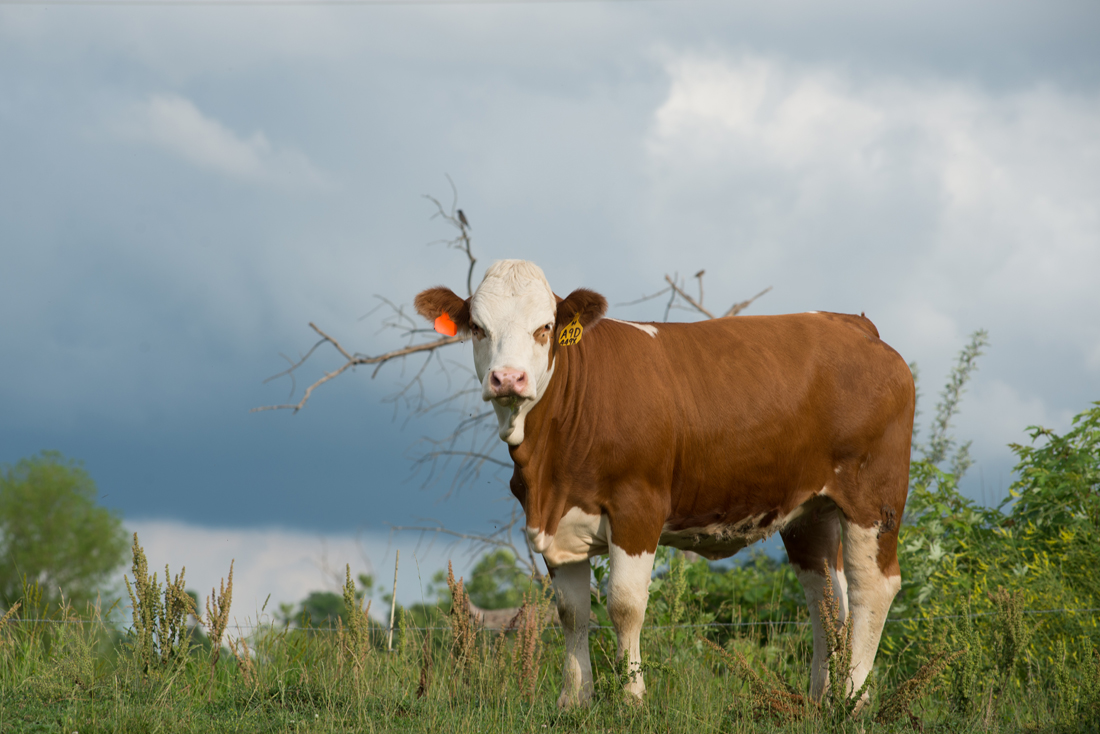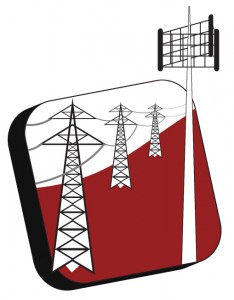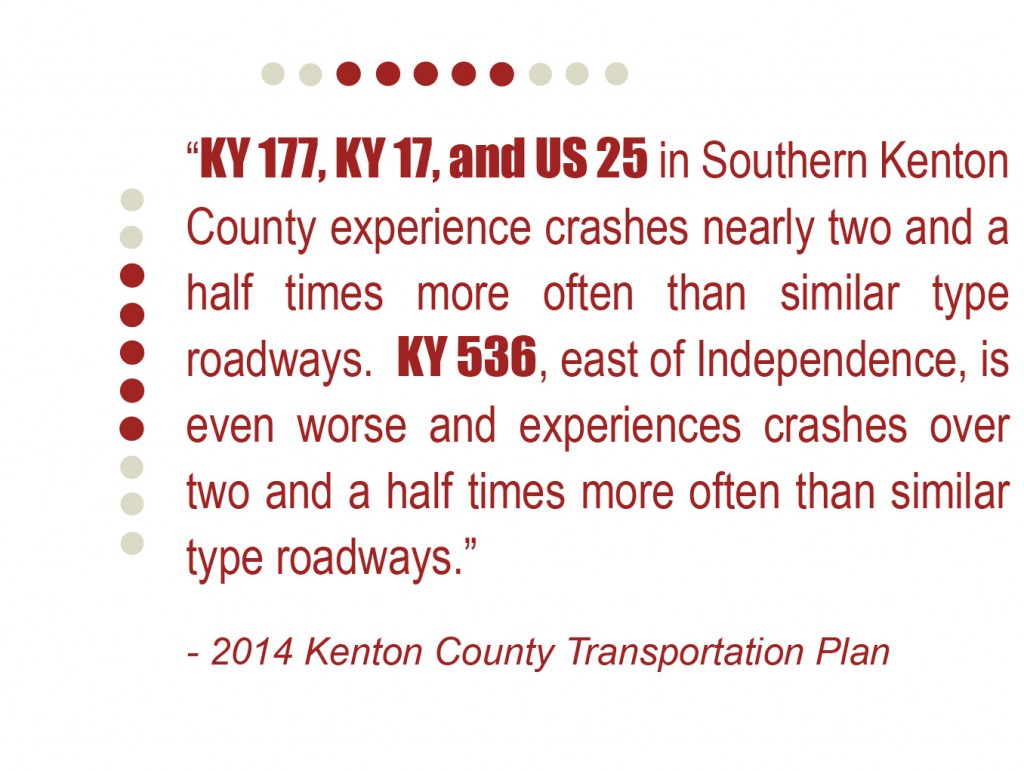About
Goals & Objectives
Elements
Research & Public Engagement
Sub Areas
Kenton County has four distinct built environments or sub areas – urban, first-ring suburban, suburban and rural. The sub-areas do not follow political boundaries and are used for planning purposes to identify the unique needs of each area. Read on to learn more about the sub area element of the plan and associated recommendations.
The Kenton County Comprehensive plan is comprised of nine elements. Recommendations and associated tasks for implementation have been developed for each element to implement the Goals and Objectives that serve as the foundation for the plan. The recommendations were derived after extensive public discussions, discourse and dialogue and are based on research which includes local data as well as national trends. They explore different facets of the county’s physical development as well as its economic and social well-being and provide a roadmap for implementation. An important part of The Comprehensive Plan is that it recognizes that Kenton County – its residents, its economy, its geography – is not homogenous. There exists a broad spectrum of different priorities and preferences that coincide with different areas of the County. The sub area element addresses policies important to specific areas of the county, but not the entire county as a whole.
Kenton County is comprised of four distinct sub areas – Rural, Suburban, First-Ring Suburban, and Urban. Each sub area is identified based on development patterns and distinct needs. There are many different geographic, social, political, and economic factors that can be addressed broadly on a countywide scale. Focusing on each sub area provides an opportunity to explore the unique needs of each area and develop policies and recommendations based on those specific needs. Explore the main headings below to learn more about the recommendations for each sub area.
Sub Areas (Rural)
Associated Goals & Objectives:
Goal 4 – Objective D
 Tasks:
Tasks:
- Consider the effect land use policies in southern Kenton County will have on the elements of rural heritage, property values, property rights, and housing prices.
- Develop model zoning regulations, based on the overall community value, that appropriately balance the need for growth and preservation in southern Kenton County.
- Evaluate cultural and recreational opportunities that are appropriate in scale to the community.
- Identify properties and buildings of historical or rural significance to recommend for the National Register of Historic Places and/or the Kenton County Register of Historic Landmarks.
Basis:
The South Kenton planning effort, which included the administration of a community-wide survey, focus group meetings and other small group meetings, indicates the general consensus in the southern part of Kenton County to keep the area rural. In addition, census data has shown a net gain in population in rural areas while there was a net loss in agricultural employment. However, there has been a growth in smaller farms and traditional farming has given way to more modern operations which promotes agritourism.
Associated Goals & Objectives:
Goal 4 – Objective D
 Tasks:
Tasks:
- Work with the South Kenton Citizens Group to develop a prioritized list of services needed.
- Encourage the South Kenton Citizens Group to investigate the needs, feasibility, and financial solutions in extending services.
- Continue to coordinate with infrastructure agencies to extend service into underserved populations where the need presents itself.
Basis:
Public input has indicated a desire for services in the area, such as access to public water and improved telecommunication service. In addition, the changing nature of agriculture requires improved rural infrastructure services that can support these operations.
Associated Goals & Objectives:
Goal 4 – Objective D
Tasks:
- Determine local, state and national trends in agricultural production and related regulations.
- Continue community dialogue regarding agriculture and identify regulatory barriers.
- Evaluate and promote regulations pertaining to agritourism.
- Remove barriers that inhibit viability and economic growth of agriculture operations.
- Encourage small-scale agriculture enterprises and related agricultural businesses through inclusive zoning regulations.
Basis:
Research has indicated a movement away from traditional forms of agriculture into modern endeavors such as agritourism, egg production, equine livestock, fruit and vegetable production, horticulture production, ornamental production, silviculture, vineyards and wine production enterprises.
Associated Goals & Objectives:
Goal 4 – Objective D
Tasks:
- Promote educational opportunities for farm operators and agritourism
- Encourage outreach to younger generations to get involved in agricultural programs and activities.
- Develop marketing programs to promote agritourism.
- Establish a comprehensive inventory of existing farming operations in Kenton County and their location.
Basis:
Historic trends continue to indicate that the number of farms in agricultural production has continued to decline. However, there has been a growth in smaller farms and traditional farming has given way to more sustainable operations which promote agritourism. Several programs are in place through the Kenton County Agricultural Extension Service and the Kenton County Conservation District to encourage future generations to consider agriculture.
Associated Goals & Objectives:
Goal 4 – Objective D
Tasks:
- Work with rural communities in the U.S. 25 corridor to examine the desire and feasibility for commercial and industrial zoning as identified in the recommended land use map.
- Research and align residential rural lot sizes, location, and layout to preserve rural character.
- Evaluate the need to locate churches and other institutional uses only along arterial and collector streets.
- Evaluate uses that may be compatible in the rural areas such as commercial recreation, agritourism, and agriculture-related commercial uses.
- Research infrastructure needed to support the agricultural economy and encouraging modern agricultural practices.
- Identify potential areas for industrial development and ensure availability of infrastructure to support these uses.
Basis:
Historically, development occurred along roadways as a result of farm and large lot subdivisions. To preserve the rural character in the area, future development should make more efficient use of the land. Zoning regulations in the Rural Sub Area are predominantly Agricultural and permits agricultural and residential uses by right. Regulations should work to promote agriculture-based businesses without sacrificing the community values.
 Associated Goals & Objectives:
Associated Goals & Objectives:
Goal 4 – Objective D
Tasks:
Identify problem areas and coordinate with the appropriate agencies to create solutions.
- Maintain existing roadways and provide better shoulders rather than develop new roads.
- Promote the installation of appropriate speed limit and marketing signs.
- Identify funding sources and apply for grant application assistance.
- Adopt rural road standards within the Kenton County Subdivision Regulations.
- Improve bicycle and pedestrian safety along OKI and Kentucky identified bike routes through increased signage, education, and improved infrastructure.
Basis:
Some of the most dangerous road segments for crashes are in the rural areas on narrow and winding country roads. A survey of south Kenton residents in Winter 2014 indicated a strong preference to better maintain existing roadways rather than build new roads.
Sub Areas (Suburban)
Associated Goal & Objective:
Goal 4 – Objective C
Tasks:![]()
Identify the needs of the aging population and determine the challenges in meeting those needs.
- Identify other strategies where the built environment can play a role in accommodating aging in place.
Basis:
Research indicates that for seniors to age in place, existing communities may require updates and changes to the built environment. Commercial areas will need to be more walkable with shops close together for easy accessibility. Housing options close to commercial areas allowing residents to walk to shops will also be a desirable option. Research indicates that lack of physical exercise is considered to be one of the major causes for the rise in obesity rates. While there are many contributing factors to decreased levels of physical activity, the built environment also influences public health.
Associated Goal & Objective:
Goal 4 – Objective C
Tasks:
- Coordinate with communities to assess their needs and the desire for mixed use development.
- Identify strategic areas and proactively pursue regulatory changes to incentivize this form of development, including areas for higher density.
- Implement a baseline standard for the proximity residential neighborhoods should be to recreation facilities and identify areas that do not meet the standard.
Basis:
Research indicates that there are shifts in lifestyle choices for certain generations, particularly the Millennials, who rent longer and desire urban living. Research also indicates that the baby boomers have a desire to age in place but are looking for convenient and easy access to amenities.
Associated Goal & Objective:
Goal 4 – Objective C
Tasks:
- Identify areas that are appropriate for lower density, larger lot developments.
- Encourage age-friendly developments such as no-step housing and low maintenance communities.
- Identify areas that are appropriate for smaller lots and higher density residential developments.
Basis:
The NKADD Housing Study identifies the need for a variety of income aligned housing options. Large lot suburban developments have long been the trend in the suburban sub area, however, there is a need for additional housing options at a variety of income levels.
Associated Goal & Objective:
Goal 4 – Objective C
Tasks:
- Identify strategic locations with easy access to major roadways where employment centers could locate.
- Identify potential areas for industrial development and ensure availability of infrastructure to support these uses.
- Encourage rezoning areas that have been identified as strategic locations for employment and industrial development.
- Collaborate with local and regional economic development agencies to proactively enhance policies that promote economic development.
- Provide, whenever feasible, access to employment and economic centers for bicyclists and pedestrians by improving facilities, connectivity, and infrastructure for these modes of transportation.
Basis:
Industrial parks are geographically situated in areas with good access to the regional transportation networks such as the interstate highway system and rail lines. In Kenton County, major industrial parks are located along the Kenton County/Boone County line due to easy access to the interstate. Improved access and infrastructure is needed in other areas in order to promote additional economic development.
Sub Areas (First-Ring)
Associated Goal & Objective:
Goal 4 – Objective B
Tasks:
- Examine existing residential, commercial, and industrial areas for vacancies and under-utilization, develop incentives, and seek grant opportunities for redevelopment.
- Create a database that tracks vacant properties in conjunction with the existing Kenton County Vacant Foreclosed Property Registry.
- Increase code enforcement efforts in designated areas to help maintain property values in areas that indicate decline.
- Work with local jurisdictions to ensure that the scale and size of new development is consistent with the appropriate character.
- Work with local experts to identify potential business and industry sites that are ready for redevelopment.
Basis:
The first-ring suburban area includes older commercial property that is vulnerable to diminished use and abandonment. As new commercial developments are built the commercial buildings in older developments suffer from loss of prime tenants and lower usage. Left unchecked this loss of use can impact neighborhoods, reduce the tax base and create a blighted area that can be difficult to redevelop. Currently, most neighborhoods in the first-ring suburbs are still in demand due to their proximity to the Interstate highway and the urban core of the Cincinnati metro area, and good school systems. It is important to monitor this area for any signs of increased vacancies. Additionally, research is finding that people are attracted to communities that have an identity and a sense of ‘place’ which is very strong in the first-ring suburbs in Kenton County.
Associated Goal & Objective:
Goal 4 – Objective B
Tasks:
- Utilize the Asset Management database to monitor and identify infrastructure improvement needs.
- Initiate efforts with local jurisdictions to improve streetscapes in strategic locations such as commercial nodes.
- Encourage filling in sidewalk gaps and promoting new bicycle and pedestrian infrastructure that promotes connectivity within the first-ring sub area and beyond.
Basis:
The well-developed street system and more compact design of the first-ring suburb is ideal for a multi-modal transportation system. Distances between residences and commercial activities are easily walkable and bikeable if the facilities to do so are present. A more robust bus system will make the first-ring suburbs more accessible for the elderly allowing them to age in place and improve access to employment centers for those in the workforce. Interest exists for a more walkable community with improved public transportation.
Associated Goal & Objective:
Goal 4 – Objective B
Tasks:
- Identify funding opportunities to preserve community assets and amenities.
- Assist local municipalities in identifying unmet needs through community dialogue.
- Encourage public gathering places and public artwork as community features that create a sense of place.
Basis:
First-ring suburbs tend to have older assets and amenities and with age can come dilapidation and obsolescence. Assets and amenities such as parks, retail shops, trails, and restaurants add to the appeal of the first-ring suburb and keep it viable. There is interest for more amenities in the first-ring suburbs.
Sub Areas (Urban)
Associated Goal & Objective:
Goal 4 – Objective A
Tasks:
- Locate grants and funding sources to assist in redevelopment.
- Use a variety of historic preservation strategies and incentives to preserve vulnerable buildings and maintain the character that draws people to urban areas.
- Work with municipalities to streamline administrative and permitting processes to help attract new industries.
- Evaluate existing zoning regulations to ensure that they are conducive to redevelopment.
Basis:
Research has found that many residents desire an urban environment in which to live. With this in mind many companies are relocating or considering locating in urban areas. To stay competitive the urban core needs to be an attractive place to work and live.
Associated Goal & Objective:
Goal 4 – Objective A
Tasks:
- Identify strategic areas that need infrastructure improvements.
- Evaluate the built environment to find innovative and cost-effective methods to reduce the amount of stormwater entering the system.
- Encourage shared and reduced parking to reduce impervious surface and the cost of maintenance.
- Repair and replace sidewalks and streetscape elements as needed, Use the asset management program to identify areas that may need sidewalk repairs and streetscape improvements.
Basis:
Infrastructure including roads, sewer, water systems and sidewalks need to be maintained and upgraded as needed for the urban area to continue to attract growth and jobs. The urban core is the oldest built environment in the county and in many areas the infrastructure is in need of repair. Currently the biggest infrastructure problem in the urban area is flooding and overflow of the wastewater system.
Associated Goal & Objective:
Goal 4 – Objective A
Tasks:
- Collaborate with local jurisdictions and other entities to identify assets that contribute most to the community’s identity and strategize how to capitalize and build upon these assets.
- Identify needed amenities in the urban core that will retain and attract new residents.
- Develop flexible regulations that permit service or commercial uses in appropriate residential neighborhoods.
Basis:
Residents call for more recreational and cultural amenities, such as a recreational center, art and music venues, and community gardens, in the urban area. These amenities will increase the attractiveness of the urban area for young adults, families and elderly generating a higher demand to reside in the urban area. Additional amenities will help to increase the number of people in the urban areas, both residing and visitors bringing more business to local retailers.
Associated Goal & Objective:
Goal 4 – Objective A
Tasks:
- Coordinate with local jurisdictions to determine feasibility of increasing mass transit in the urban area.
- Identify locations for the installation of bicycle and pedestrian infrastructure enhancements and improvements. Some examples of these enhancements could include but are not limited to signage, sharrows, dedicated and protected bicycle lanes, median improvements, lighting, bicycle parking, and multi-use trails.
- Assist local municipalities in securing funding for alternative transportation facilities.
Basis:
Residents desire more public transportation and bike facilities in the urban area. Increasing the use of these modes of transportation can reduce traffic congestion and air pollution in the area. Alternative modes of transportation will mean the elderly will not have to use an automobile to get around; and the young will have choices to make living in the urban core easier.

